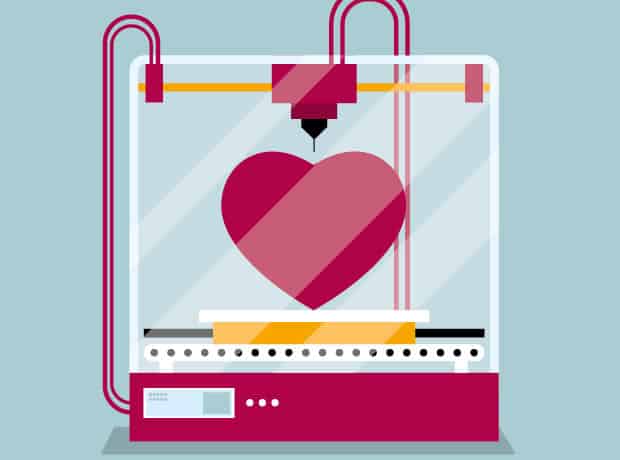Imagine a future where patients with multiple chronic conditions no longer have to take numerous drugs several times a day – instead they can take one tablet containing all the required medications, once-daily, thanks to 3D printing.
Known as additive manufacturing, 3D printing starts with a computer-aided design of a digital model of the product. The design is then sliced into thousands of horizontal layers that will form the digital file for feeding into a 3D printer. It will then use different materials to print the product layer by layer, transforming two-dimensional layers into a 3D product. Although the technology was developed in the 1980s, it is only in the last decade or so that 3D printing has found widespread industrial applications, from the production of automotive parts to machine tools. In the healthcare arena, the medical device industry is amongst the first to utilise 3D printing, producing hearing aids, dental implants and prostheses. The pharmaceutical industry is a laggard but is now waking up to the potential that 3D printing has to offer.
Precision and personalised medicines
The ability of 3D printing to produce medications to exact specifications tailored to the needs of individual patients has led some observers to predict the advent of more precision and personalised medicines. The technology allows tablets to be precisely printed in shapes, sizes and textures which are difficult to produce using traditional production techniques. It can print tablets which aid swallowing, have different release rates and possess taste and appearances acceptable to children, thus improving adherence. For example, a pyramidal shaped tablet will be absorbed quicker than a cylindrical one.
Another advantage is that tablets can be printed to contain several active ingredients, with the dosage of each medicine personalised to the patient’s age, gender, race, weight, genetic makeup and biochemical profiles. Individualised dosing may reduce adverse events, especially for medicines with narrow therapeutic index. In orphan diseases, it will be more cost-effective to print small quantities of medicines as required rather than rather mass-producing an entire batch with limited shelf life.
Are we there yet?
In August 2015, Aprecia in New Jersey, USA, received the first-ever FDA-approved 3D printing medicine – Spritam for epilepsy. It is a formulation of levetiracetam that was created as a porous pill which disintegrates rapidly with a sip of liquid. This is advantageous in children and elderly patients who have difficulty swallowing tablets which contain a high drug load. Patients with epilepsy can ill-afford to miss any dose as the consequence of poor adherence is obvious. It will be the first of several CNS drugs developed under its proprietary ZipDose technology, which is exclusively licensed to Aprecia by Massachusetts Institute of Technology for pharmaceutical applications worldwide.
In the same year, Howard Hughes Medical Institute at Maryland, USA, announced that it had developed a 3D printer using a single automated process to synthesise 14 classes of small molecules from a common set of chemical building blocks. It envisaged expanding the approach to produce thousands of small molecules from a single machine and allow potential therapeutics to be synthesised for human research. Many of these small molecules occur naturally in plants, animals and microbes which can be modified and then synthesised by 3D printing in drug discovery.
On our own shores, in 2014, University College London spun-out FabRx with the aim of ‘developing printed medicines and drug-loaded medical devices’. Its proprietary Printlets technology offers a platform to ‘formulate and manufacture 3D printing medicines with any drug compound’, including polypills which incorporate multiple medicines. FabRx can print medicines using a range of excipients to design medications possessing any desired drug release profile, including dispersible tablets that dissolve rapidly in the mouth or chewable formulations like gummies which are more palatable to children and the elderly. It hopes 3D printing would be used widely in the industry and is open to collaborations with mainstream pharma.
An enabler or disruptive technology?
We could see a future where, following a GP appointment, patients’ encrypted prescriptions are sent online to their local pharmacy, where a pharmacist takes their physical measurements, performs a finger-prick blood test and inputs the data online on the 3D printing medicines portal. In a few minutes, the design file downloads to the pharmacy’s 3D printier, which prints out the personalised doses of several medicines as a polypill to be taken once daily. One day the patient may even be able to print their repeat medications at home using a personal machine.
As with any nascent technology, regulations will always play catch-up. While it is now possible to print many medications via 3D printing, it does not mean that patented medicines can be printed without the agreement of innovator companies. Does this mean that only generic medicines can be printed for the time being? Would desktop 3D printers have to undergo the same approval process as any manufacturing facility? Medicines are only licensed after exhaustive clinical trials using a small number of fixed doses. As such, regulations would have to be rewritten to permit printing of personalised doses unique to each patient. How would regulators handle the varied combinations of medicines in a single tablet that has never been studied in a clinical trial? How do you attribute an adverse event after taking a polypill? If there is a product technical complaint, where does the liability lie; the software designer, hardware producer, active ingredient and excipient manufacturers? Will 3D printing lead to an upsurge of counterfeiting or proliferation of illegal drugs?
While the above legitimate questions require regulatory resolution, it is doubtless that the advantages of 3D printing outweigh its challenges and that individual patients will be the ultimate beneficiaries of this latest advancement in medicine.
Dr Stephen Huang is a pharmaceutical medicine consultant and James Huang is a policy researcher, both at SCP Medical






